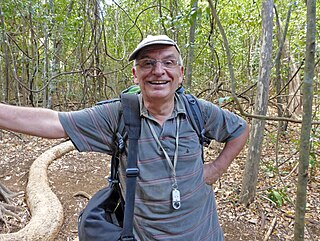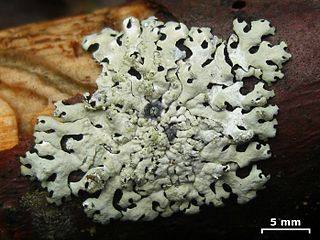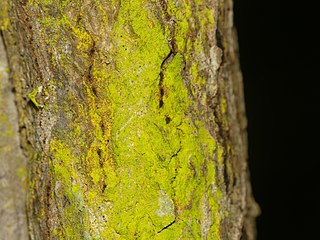
Friedrich Martin Josef Welwitsch was an Austrian explorer and botanist who in Angola was the first European to describe the plant Welwitschia mirabilis. His report received wide attention among the botanists and general public, comparable only to the discovery of two other plants in the 19th century, namely Victoria amazonica and Rafflesia arnoldii.

Protea welwitschii is a species of shrub or small tree which belongs to the genus Protea, and which occurs in bushveld and different types of grassland.

Xanthoparmelia is a genus of foliose lichen in the family Parmeliaceae. Xanthoparmelia is synonymous with Almbornia, Neofuscelia, Chondropsis, Namakwa, Paraparmelia, and Xanthomaculina. This genus of lichen is commonly found in the United States, as well as Australia, New Zealand and Ecuador.
Tylophorella is a genus of lichen-forming fungi in the order Arthoniales. The genus has not been placed into a family. Tylophorella was circumscribed by Finnish lichenologist Edvard August Vainio in 1890, with Tylophorella polyspora assigned as the type species. T. pyrenocarpoides was added to the genus in 1993.

William Philip Hiern was a British mathematician and botanist.

Xanthoparmelia mexicana, commonly known as the salted rock-shield, is a foliose lichen in the family Parmeliaceae. It grows in 4–10 cm diameter rosettes of gray-green to yellow-green lobes in arid climates all over the world.

Edvard August Vainio was a Finnish lichenologist. His early works on the lichens of Lapland, his three-volume monograph on the lichen genus Cladonia, and, in particular, his study of the classification and form and structure of lichens in Brazil, made Vainio renowned internationally in the field of lichenology.
Lepidocollema wainioi is a species of lichen in the family Pannariaceae. It is known from southeast Asia.
Josef Hafellner is an Austrian mycologist and lichenologist. He was awarded the Acharius Medal in 2016 for his lifetime contributions to lichenology. Before his retirement, he was a Professor at the Karl-Franzens-Universität in Graz. Hafellner started developing an interest in lichens while he was a student at this institution, studying under Josef Poelt. He earned a master's degree in 1975 and a PhD in 1978, defending a doctoral thesis about the genus Karschia. In 2003, Hafellner received his habilitation. By this time, he had studied with French lichenologist André Bellemère (1927–2014) at Saint-Cloud, where he learned techniques of transmission electron microscopy and how their application in studying asci could be used in lichen systematics. His 1984 work Studien in Richtung einer natürlicheren Gliederung der Sammelfamilien Lecanoraceae und Lecideaceae has been described as "probably the single most influential publication in lichen systematics in the latter half of the 20th century".
Caloplaca vainioi is a species of crustose lichen in the family Teloschistaceae. It is based on the name Placodium brebissonii var. microspora, collected by Friedrich Welwitsch in Angola and described by Edvard August Vainio in 1901. In 1979, lichenologists Josef Hafellner and Josef Poelt renamed this taxon to Caloplaca vainioi. Thorsten Lumbsch and colleagues indicated that this species is the same as Caloplaca cateileoides, and proposed placing the two in synonymy. However, Clifford Wetmore questioned the synonymy of these species, noting that their lichen spot tests and hymenium colour were different, and suggested that "further collections and study are necessary".
Cladonia wainioi or the Wainio's cup lichen is a species of cup lichen found in boreal and arctic regions of the Russian Far East and northern North America.
Rolf Santesson (1916–2013) was a Swedish lichenologist and university lecturer. He was awarded the Acharius Medal in 1992 for his lifetime contributions to lichenology.
Coppinsidea vainioana is a species of crustose lichen in the family Ramalinaceae. It occurs in Europe, where it grows on the bark of pine trees.

Emmanuël Sérusiaux is a Belgian lichenologist. His career, spanning more than four decades, has combined both lichenology research and political aspects of nature conservation. He spent several periods working as a researcher at the National Fund for Scientific Research and the University of Liège, the latter in which he accepted a faculty position as professor and head of the Plant Taxonomy and Conservation Biology unit. Sérusiaux also served for three non-consecutive appointments as Deputy Chief of Staff in the Government of Wallonia. He retired from both his academic and political positions in 2019.
Punctelia ruderata is a species of foliose lichen in the family Parmeliaceae. It is a member of the Punctelia rudecta species complex. Found in Asia and East Africa, it was first formally described as a new species in 1921 by Finnish lichenologist Edvard August Vainio as Parmelia ruderata. The type was collected by Atsushi Yasuda in Honshu, Japan, where it was found growing on tree bark. The lichen was reported from South America in a 2009 Ph.D. thesis, and the taxon transferred to the genus Punctelia. The new combination, however, was not validly published, and molecular phylogenetic analysis showed that the species does not occur in Brazil. The name was resurrected and validly published in 2016.

Parmelina quercina is a species of foliose lichen in the large family Parmeliaceae. It is found in continental Europe.

Hypotrachyna osseoalba, commonly known as the grainy loop lichen, is a species of foliose lichen in the family Parmeliaceae. It is widely distributed in subtropical and temperate areas of the world. Characteristic features of the lichen include the pustules in its cortex, the somewhat linear shape of the lobes comprising the thallus, and the branched rhizines.

Lecanographa dialeuca is a species of saxicolous (rock-dwelling) crustose lichen in the family Roccellaceae. It is found in Cape Verde and Europe.

Chrysothrix xanthina is a widely distributed species of leprose lichen in the family Arthoniaceae. It has a bright yellow to bright greenish-yellow, thin, granular thallus, and typically grows on bark, although it is infrequently found growing on rock.
Biatora oxneri is a species of corticolous (bark-dwelling) lichen in the family Ramalinaceae. It is found in the Russian Far East and in South Korea.










